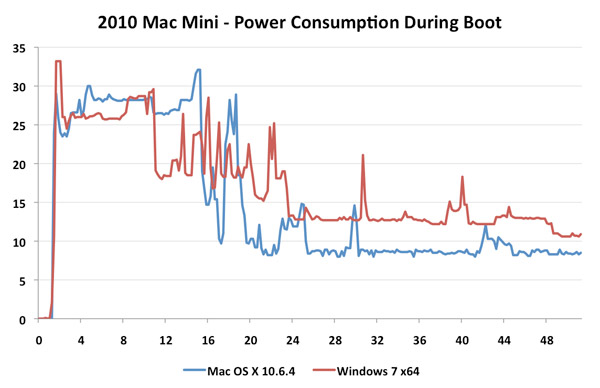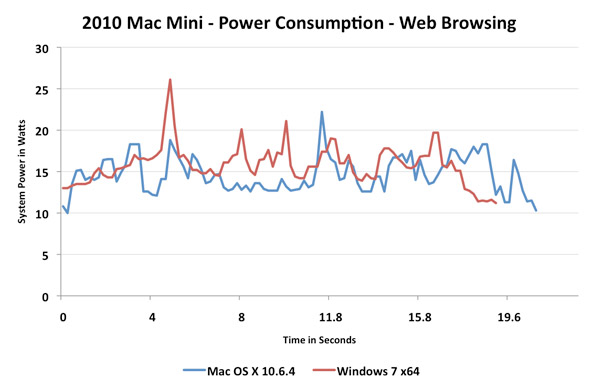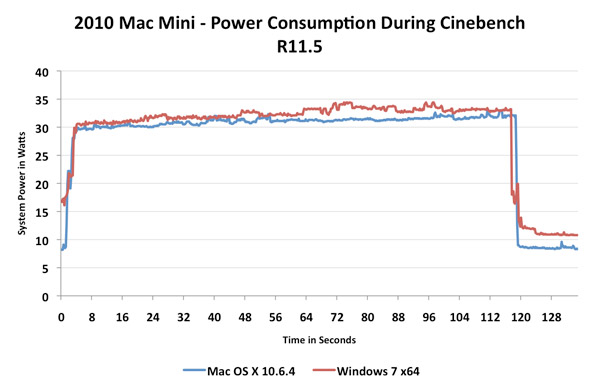Apple Mac mini Review (Mid 2010)
by Anand Lal Shimpi on August 9, 2010 3:37 AM ESTHonest Apple & Energy Efficiency
Apple calls the new Mac mini the world’s most energy-efficient desktop computer. I thought that might be a bit of a stretch but if you look at the numbers, they’re very convincing.
Zotac’s HD-ID11, an Atom based next-generation ION nettop, idles at 21.7W. Even the ASUS UL50V notebook, with a Core 2 Duo SU7300 (1.3GHz) ultra low voltage notebook CPU idles at 8.1W with the screen disabled.
Now that 8.1W number is unrealistic for a notebook. The screen was disabled, battery removed, WiFi disconnected and no ethernet cables plugged in. If I run the 2010 Mac mini in a similar configuration (minus the display/battery part since, well, they don’t exist), the entire system consumes 7.5W at idle.
Connect to a WiFi network, plug in an Ethernet cable and you’re looking at 8W. I have not seen a modern desktop machine idle at lower power than the 2010 Mac mini.
| 2010 Mac mini Power Usage | ||||||||
| Idle | Half Life 2 Episode Two | DVD Playback | Web Browsing | Quicktime Encode | Cinebench R11.5 | |||
| Apple Mac mini (Mid 2010) | 8.0W | 26.4W | 16.1W | 8.6W - 19W | 30.3W | 30.0W | ||
Part of this has to do with Apple’s very efficient integrated PSU. Unlike the other two systems I mentioned here, the mini uses a custom, integrated 85W PSU specifically designed for the system’s load.
Part of it has to do with Apple’s component selection. The mini is built entirely out of notebook parts with a custom motherboard design devoid of anything unnecessary. I’ve even heard that Apple goes to great lengths to ensure the CPUs/GPUs/chipsets it gets are on the lower power portion of the yield curve for products like the mini or MacBook Air.
The third explanation for why Apple is able to make such a bold claim about the Mac mini’s power consumption has nothing to do with hardware at all. As we’ve shown in the past, Mac OS X tends to offer better battery life than Windows in situations where the system sees a lot of idle time. Reading web pages, typing a document, etc... all tend to expose this advantage. Under load however, the OS X power advantage disappears - we are after all dealing with the same components regardless of OS.
The idle battery life advantage comes from lower idle power, presumably through heavy OS and hardware optimization. While I measured 8W at idle under OS X, running Windows 7 (power saver mode) on the Mac mini resulted in a 12W idle power without any changes to the hardware. Granted I don’t have identical hardware by another manufacturer to confirm that this isn’t negligence on Apple’s part to optimize its firmware for Windows 7. However in the past we’ve shown that systems from Lenovo, despite having similar specifications to Apple notebooks deliver worse idle battery life. I believe it’s safe to assume that part of the reason Apple is able to make such a bold claim about the mini’s energy efficiency is because it is the only desktop that can be sold running Mac OS X.
I recorded the mini’s power consumption over time running both OS X 10.6.4 and Windows 7 x64 to give you an idea of where the power consumption differences come into play.
This first chart shows power consumption during the boot process. From power on until you get a cursor at the desktop and the system’s power draw stabilizes for a while. The red line is Windows 7, the blue line is OS X:

Peak power consumption is nearly identical between the two OSes during the boot process. However, OS X drops down to idle sooner (finishes booting quicker) and remains at a lower idle point than Windows 7. Both OSes experience blips of activity after we reach the desktop as additional services are started.
The next test is some basic web browsing using Chrome. I loaded the AnandTech front page, scrolled to an article, clicked on it, scrolled down to the comments and recorded system power consumption:

I tried to get both runs as close as possible to one another, but I am human. Even while browsing the web the CPU has ample time to go into lower power states. Total platform power dips lower under OS X and is lower overall.
Our final test shows a run of Cinebench R11.5. The legend is the same, red for Windows, blue for OS X, but this time the CPU is pegged at 100% for the duration of the test:

The two systems are nearly identical in terms of power consumption. OS X still offers a slight advantage that’s consistent but not pronounced. The render completes in approximately the same amount of time in both OSes, although Windows is a hair quicker. The mini under OS X scored 1.38 points vs. 1.39 under Windows 7.
Since there is a performance difference here, it could just be that Apple is optimizing for power consumption rather than peak performance in the OS itself. It’s difficult to analyze but it’s something I am seeing fairly consistently.










93 Comments
View All Comments
iwodo - Monday, August 9, 2010 - link
By end of 2012, we should be able fit Sandy Bridge, 4GB Ram, SSD, and a much faster GFX within the same size.james.jwb - Monday, August 9, 2010 - link
We will never get to the end of 2012 :)tech6 - Monday, August 9, 2010 - link
The Apple box is nice but its too bad Apple feels the same way about Blue Ray than they do about Flash (and SSDs apparently).The ASRock i3 based box reviewed earlier is much better value for those seeking an HTPC. For around $700 it delivers i3 performance, a remote as well as BD.
Oscarcharliezulu - Monday, August 9, 2010 - link
Is the CPU soldered in place? No chance of diy CPU upgrades?
futurepastnow - Monday, August 9, 2010 - link
Yes, it is. Can't you tell just by looking at it?Ratman6161 - Monday, August 9, 2010 - link
It's almost as if they scoured their parts bins for the parts that were obsolete and would otherwise be thrown out and stuck them in a white plastic box and slapped a $699 price tag on it. It may be the cheapest way to get a new OS X system - but it seems to me like Apple has lost it's way with this product. If the goal were to lure new OS X users, I suppose I could see this if it were priced at about $300.I know Apple people hate price comparisons with Windows PC's but since the hardware is basically identical these days, the comparisons are inescapable. I recently bought my wife a new HP laptop at Best Buy. It has an i3 330M (which blows away the 2.4 GHZ core 2 duo in my Dell laptop by the way), has 4 GB of RAM and a 500 GB 7200 RPM hard drive. And of course the laptop has to include a screen as well. It cost $649.00 + tax. Given spare parts bin components being used, there is just no way that the Mini should cost more.
Like I said, you have to really want OS X to buy this.
Ratman6161 - Monday, August 9, 2010 - link
I forgot to mention that this thing comes with absolutely no input devices so if you want Apple stuff the real price is $819. And unlike a laptop it doesn't even need a battery.futurepastnow - Monday, August 9, 2010 - link
While I couldn't care less about Apple's mouse and keyboard, upgrading the mini (via Newegg, not Apple) to 2x2GB of RAM and a 7200 RPM drive increases the total to nearly $840. That's completely unacceptable.fic2 - Monday, August 9, 2010 - link
My laptop doesn't need a battery unless I want to use it on the go. It is usually plugged into a wall sitting on my desk at work with the battery laying next to it.v12v12 - Monday, August 9, 2010 - link
Haha I 2nd these comments of common-sense! This is nothing but another overpriced Apple rehash of old-technology into a small, shiny, sleek, box. Profiteering for "Apple" is merely how to out fox the fanatical, tech-obsessed "Mac-phile" user base, out of their snidely earned cash.It's way out of date, comes with sub-standard parts, no BR, "mini" crap ports, sub-par full HDMI port blah blah. Oh and the PRICE? I know the editors have to give Apple a soft, white pillow to slam them down on, but come on... Take a look at these quotes right here;
"The user experience of the Mac mini is noticeably diminished by only having 2GB of memory."
“There are actually no input devices included in the purchase price, so expect to add another $120 if you want an Apple keyboard and Magic Mouse ($140 if you want them to both be wireless). There’s no remote included either, although Apple’s IR remotes do work with the mini.”
That's a very polite way of saying something (honest) such as, "Apple is again cutting corners in the hardware department, yet making it seem 'adequate' for most users." Is 2GB "fine" for 8/10 “users” (highly ambiguous!?) YEP sure is. I work with a huge Win/OSX client base and NOBODY is screaming about needing 4GB of ram, but the industry standard IS 4GB now. 2 is "acceptable," but not up to pace. It's per user's demands, but (in general) anyone with experience dealing with "Apple" knows they've cut corners again. You just softened the blow.
Let’s recap; SEVEN HUNDRED DOLLARS ($820*) for:
-No peripherals*---WTF?
--Dated CPU
---Sub-par Ram (should I bother asking about timings/quality of the Dimms, lol?)
----Sketchy Vid-output connections (HDMI 1900x1200!)
-----Sub-par GPU vs a laptop (all it is stuffed in a small box)
----Sub-par 5400rpm HD. (Is this a joke?)
---No SSD???
--PRICE! (Overpriced KB/M?)
-No IR remote (this IS marketed as an HTPC?!)
And lastly... dealing with "Apple" is nothing but a PITA if you're not blindly "appeased" with what they've attempted to brainwash you into buying, and then spoon-fed to you. Oh BTW... it's up to YOU to provide your own bib and paper towel to wipe off all that drool. That is until you use the thing and realize; OMFG I shoulda gotten a smaller LAPTOP instead.
__Apple MARKETING is very, very keen on deception and mental-washing and this is how; SMALL FORM FACTORING (SFF). SFF'ing is nothing but a MARKETING ploy.